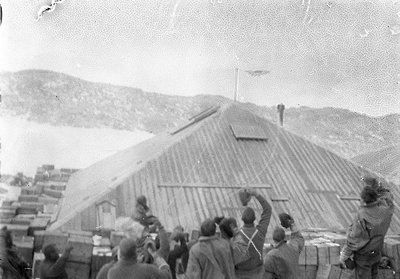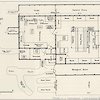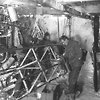Home at 'the Hut'
The next day, 25 January, a section of roof was completed, enabling Walter Hannam to abandon his sledging-cooker and begin using the stove for meals. From that day the group moved progressively into the Hut. By 30January all were sleeping under its nearly-finished roof, and by early February — a mere fortnight after the ship’s departure, the men’s Antarctic home was finished.
The main living quarters (‘the Hut’) was a single room, about 7.3 metres square, with a pyramid-shaped roof, surrounded on three sides with an enclosed veranda to serve both as store-rooms and added insulation.
The main feature of the room was a long central dining table with platform seating on either side. Around the walls were the men’s bunks (Mawson was the only person to have his own room), a corner photographic darkroom for Frank Hurley, and a ‘kitchen’ comprising a dresser, a couple of benches and, of course, the cherished stove, centrepiece for many a conversation.
Off the fourth wall of the living quarters was a second, conjoined building enclosing a smaller space, the ‘workroom’, 5.5 metres by 4.9 metres. This building was originally designed to accommodate the party for a third Antarctic base, but Mawson abandoned this idea well before arriving in Cape Denison.
The workroom contained benches for carpentry, mechanical and scientific work — as well as the crucial wireless operator’s bench. Along one outer wall of the workroom was enclosed accommodation for the 19 dogs, about 1.5 metres wide, and along the other the entrance porch and latrine.
To the west of the Main Hut, adjoining the biological store, was the ‘hangar’, erected to house the AAE’s now-flightless Vickers aircraft, which Bickerton would maintain for use as an ‘air tractor’ to tow heavy sledges up the ice slopes.
The buildings were sturdy, but presented a significant obstacle to the exceptional katabatic winds of Cape Denison, making them a candidate for rapid destruction. But any doubts about their ability to withstand the elements were put to rest by the build-up of drift snow around the walls. ‘Within a few days after construction,’ wrote Mawson later, the whole structure was well frozen together and buried beneath drifts of hard-packed snow.’



